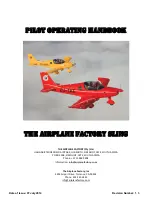
Java
150
Owner`s Manual
FLYING THE JAVA
Please note the following is not meant to be an exhaustive flying manual but merely a
brief note and should be read with that in mind.
Take off
Before take-off MAKE SURE that you have pre-flight checked the glider, that you
are clipped in and that you have performed an adequate hang check.
On take-off the wings should be held level with the nose slightly raised. A strong and
committed take off run is always recommended. Keep the angle of attack low until
you are running fast. Once sufficient air speed has been achieved increase the angle of
attack gradually to take off. Once settled in flight move your hands to a comfortable
position on the base bar.
In Flight
The control in both pitch and roll is light and precise. Accordingly the glider should
be flown with moderate and precise inputs. The glider should not be flown too slow
or in a semi-stalled condition as the roll response becomes much slower.
Stall
The Java recovers quickly from stalls but will lose height doing so. A wing close to
the stall becomes difficult to control. For both these reasons the glider should be
flown with sufficient airspeed close to the ground, hill or any other aircraft.
Spin
Hang gliders are generally resistant to spin. It is very unlikely that you will ever
experience a spin in normal flight. To recover from a spin pull the bar in and
increase speed BEFORE applying opposite bank.
Flying with a wet glider
DO NOT TEST YOUR NEW GLIDER IF IT IS WET. Wet gliders do not fly nearly
as well as dry gliders. This is because the water droplets on the leading edges disturb
the airflow over the wing. The result is that the glider does not perform so well and
stalls at a much higher airspeed. I.E. you will not be able to fly the glider as slowly
as if it were dry. You may also find that the glider stalls more easily, takes longer to
recover from a stall and as a result is more prone to spinning.
If you get caught in the rain as the glider gets wetter you will notice the above effects
increase. You will have to fly faster to avoid stalling and should be especially careful
on landing. We advise that you fly with a lot of excess speed when doing any
manoeuvres near the ground or other aircraft with a wet glider.
13










































